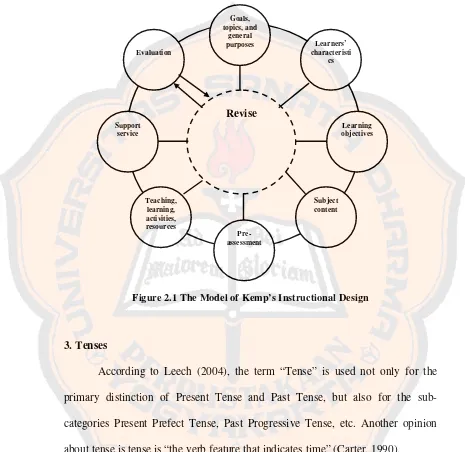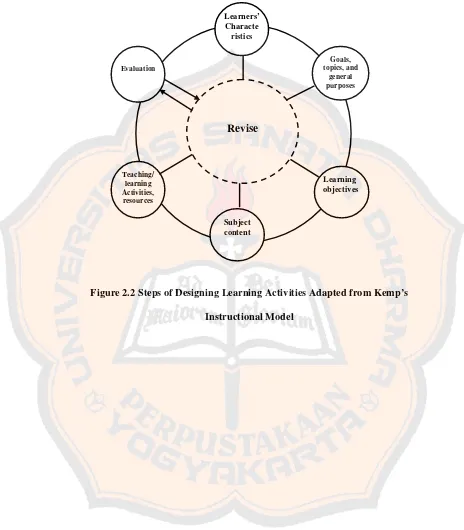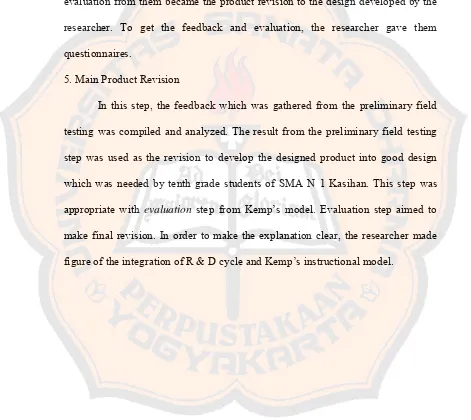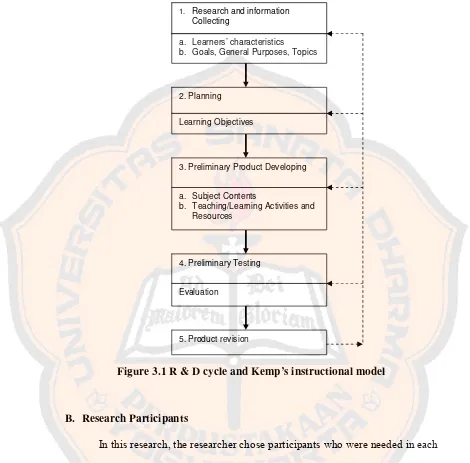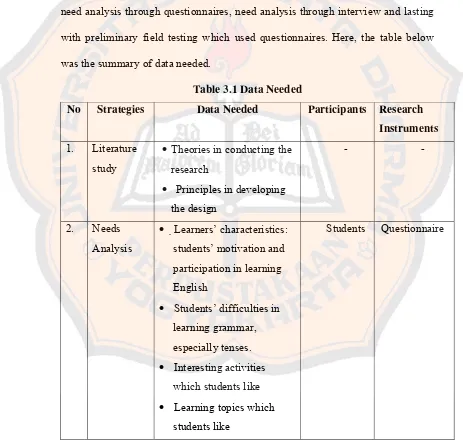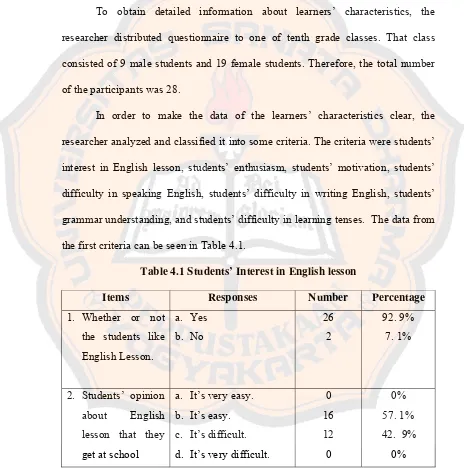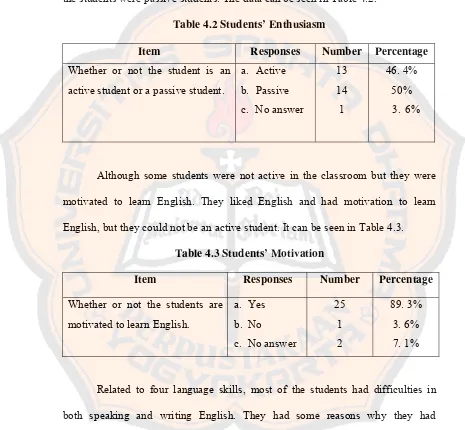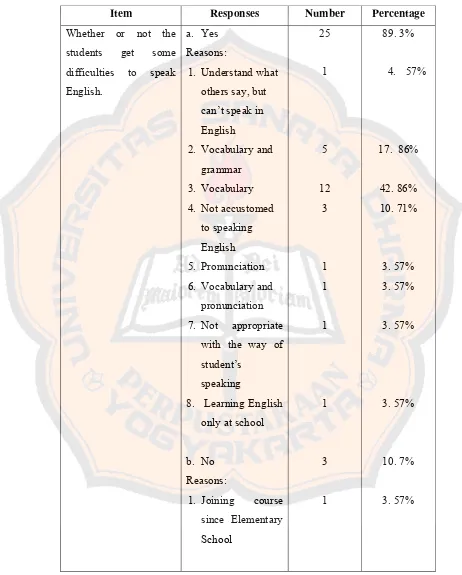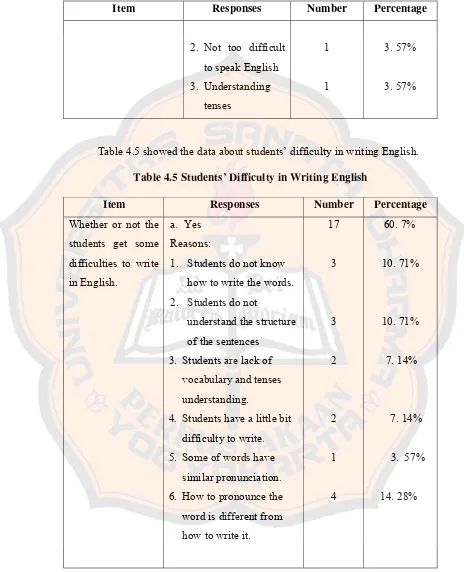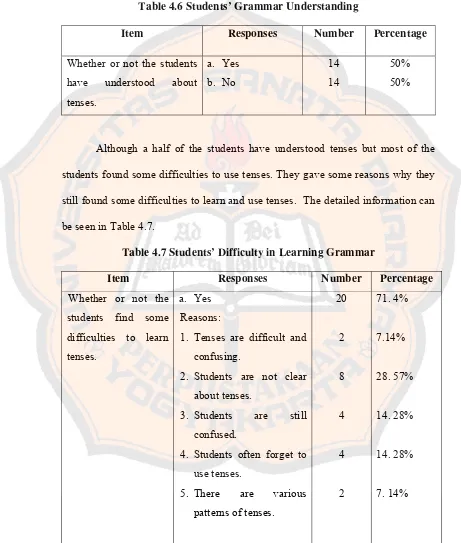THE DESIGN OF LEARNING ACTIVITIES TO DEVELOP STUDENTS’ ABILITY TO USE PAST TENSES IN SPEAKING
AND WRITING SKILLS FOR TENTH GRADE STUDENTS OF SMA 1 KASIHAN
A THESIS
Presented as Partial Fulfillment of the Requirements to Obtain the Sarjana Pendidikan Degree
in English Language Education
By
Kristina Dwi Oktavia Student Number: 061214027
ENGLISH LANGUAGE EDUCATION STUDY PROGRAM DEPARTMENT OF LANGUAGE AND ARTS EDUCATION FACULTY OF TEACHERS TRAINING AND EDUCATION
SANATA DHARMA UNIVERSITY YOGYAKARTA
i
THE DESIGN OF LEARNING ACTIVITIES TO DEVELOP STUDENTS’ ABILITY TO USE PAST TENSES IN SPEAKING
AND WRITING SKILLS FOR TENTH GRADE STUDENTS OF SMA 1 KASIHAN
A THESIS
Presented as Partial Fulfillment of the Requirements to Obtain the Sarjana Pendidikan Degree
in English Language Education
By
Kristina Dwi Oktavia Student Number: 061214027
ENGLISH LANGUAGE EDUCATION STUDY PROGRAM DEPARTMENT OF LANGUAGE AND ARTS EDUCATION FACULTY OF TEACHERS TRAINING AND EDUCATION
SANATA DHARMA UNIVERSITY YOGYAKARTA
iv
“The future belongs to
those who believe in the
beauty of their dream”
(Elanor Roosevelt)
I dedicate this thesis to all
v
STATEMENT OF WORK’S ORIGINALITY
I honestly declare that this thesis, which I have written, does not contain the work or parts of the work of other people, except those cited in the quotations and the references, as a scientific paper should.
Yogyakarta, 4 February 2011 The Writer
vi ABSTRACT
Oktavia, Kristina Dwi. 2011. The Design of Learning Activities to Develop Students’ Ability to Use Past Tenses in Speaking and Writing Skills for Tenth Grade Students of SMA N 1 Kasihan. Yogyakarta: English Language Education Study Program, Sanata Dharma University.
Learning tenses is an important activity which can be used to support English speaking and writing classes. Since speaking and writing skills are productive skills, therefore, the students are required to be able to use tenses while they are speaking and writing in English. The fact showed that tenth grade students of SMA N 1 Kasihan found difficulty when they were speaking and writing in English. The sentences which they produced were not in a good order. Therefore, this study attempted to design learning activities to develop students’ ability to use past tenses in English speaking and writing skills.
This study was aimed to help the senior high school teachers provide learning activities to develop students’ ability to use past tenses in speaking and writing skills. There was one problem to solve in this study: What is the design of learning activities to develop students’ ability to use past tenses in speaking and writing skills for ten grade students of SMA N 1 Kasihan?
This study was done by conducting the steps of Kemp’s instructional design model which was put under the umbrella of Borg and Gall’s R&D cycle. This study considered relevant theories related to tenses, learning activity, speaking skill, writing skill, direct method, total physical response, audiolingual method, cooperative language learning to design learning activities to develop students’ ability to use past tenses in speaking and writing skills for tenth grade students.
This study has found the answer to the formulated problem above. The design of learning activities to develop students’ ability to use past tenses in speaking and writing skills for tenth grade students is learning activities design which includes identification of learners’ characteristics, the statement of competence standard, basic competence, topics, and objectives, the list of subject contents, learning activities design, and also experts’ validation and evaluation for the design revision.
The designed learning activities consisted of four designs. The first design was learning simple past tense in learning recount for speaking class. The second design was learning simple past tense in learning recount for writing class. The third design was learning past progressive tense in learning narrative for speaking class and the last design was learning past perfect tense in learning narrative for writing class.
vii ABSTRAK
Oktavia, Kristina Dwi. 2011. The Design of Learning Activities to Develop Students’ Ability to Use Past Tenses in Speaking and Writing Skills for Tenth Grade Students of SMA N 1 Kasihan. Yogyakarta: Program Studi Pendidikan Bahasa Inggris, Universitas Sanata Dharma.
Pembelajaran tenses merupakan kegiatan yang penting yang dapat digunakan untuk mendukung kelas berbicara dan menulis bahasa Inggris. Karena ketrampilan berbicara dan menulis merupakan ketrampilan memproduksi, oleh karena itu para siswa dituntut agar dapat menggunakan tenses ketika mereka berbicara dan menulis dalam bahasa Inggris. Fakta menunjukkan bahwa siswa-siswa kelas sepuluh SMA N 1 Kasihan menemukan kesulitan ketika mereka berbicara dan menulis dalam bahasa Inggris. Kalimat yang mereka hasilkan tidak dalam susunan yang bagus. Oleh karena itu, studi ini mencoba untuk mendesain kegiatan pembelajaran untuk mengembangkan ketrampilan siswa menggunakan past tenses dalam ketrampilan berbicara dan menulis bahasa Inggris.
Studi ini bertujuan untuk membantu para guru bahasa Inggris di SMA menyediakan kegiatan pembelajaran untuk mengembangkan ketrampilan siswa menggunakan past tenses dalam ketrampilan berbicara dan menulis. Terdapat sebuah permasalahan untuk dipecahkan dalam studi ini: Seperti apa desain kegiatan pembelajaran untuk mengembangkan ketrampilan siswa menggunakan past tenses dalam ketrampilan berbicara dan menulis bagi para siswa kelas sepuluh SMA N 1 Kasihan?
Studi ini diselesaikan dengan menerapkan langkah-langkah dari model desain materi Kemp yang dimasukkan ke dalam langkah-langkah metode penelitian dan pengembangan pendidikan (R&D) Borg dan Gall. Studi ini juga menggunakan teori-teori yang berkaitan dengan tenses, kegiatan pembelajaran, ketrampilan berbicara, ketrampilan menulis, direct method, total physical response, audiolingual method, cooperative language learning untuk mendesain kegiatan pembelajaran untuk mengembangkan ketrampilan siswa menggunakan past tenses dalam ketrampilan berbicara dan menulis bagi para siswa kelas sepuluh.
Studi ini telah menemukan jawaban atas permasalahan yang telah dirumuskan di atas, desain kegiatan pembelajaran untuk mengembangkan ketrampilan siswa menggunakan past tenses dalam ketrampilan berbicara dan menulis bagi para siswa kelas sepuluh adalah desain kegiatan pembelajaran yang mencakup adanya identifikasi karakteristik siswa, pernyataan tujuan desain, standar kompetensi, kompetensi dasar, topik, daftar materi, desain kegiatan pembelajaran, dan juga validasi dan evaluasi dari para ahli untuk merevisi desain tersebut.
viii
keempat yaitu pembelajaran past perfect tense dalam pembelajaran narrative untuk kelas menulis.
ix
LEMBAR PERNYATAAN PERSETUJUAN
PUBLIKASI KARYA ILMIAH UNTUK KEPENTINGAN AKADEMIS
Yang bertanda tangan di bawah ini, saya mahasiswa Universitas Sanata Dharma:
Nama : Kristina Dwi Oktavia
Nomor Mahasiswa : 061214027
Demi pengembangan ilmu pengetahuan, saya memberikan kepada Perpustakaan Universitas Sanata Dharma karya ilmiah saya yang berjudul:
THE DESIGN OF LEARNING ACTIVITIES TO DEVELOP STUDENTS’ ABILITY TO USE PAST TENSES IN SPEAKING AND WRITING SKILLS FOR TENTH GRADE STUDENTS OF SMA 1 KASIHAN
Dengan demikian saya memberikan kepada Perpusatakaan Universitas Sanata Dharma hak untuk menyimpan, mengalihkan dalam bentuk media lain, mengelolanya dalam bentuk pangkalan data, mendistribusikan secara terbatas, dan mempublikasiskannya di Internet atau media lain untuk kepentingan akademis tanpa perlu meminta ijin dari saya maupun memberikan royalty kepada saya selama tetap mencantumkan nama saya sebagai penulis.
Demikian pernyataan ini saya buat dengan sebenarnya.
Dibuat di Yogyakarta
Pada tanggal: 4 Februari 2011
Yang menyatakan
x
ACKNOWLEDGEMENTS
I would like to thank and praise to Jesus Christ for giving me His blessing and guidance during the process of completing this thesis. God never stops
guiding and giving me miracles and strength to complete this thesis.
I would express my gratitude to my thesis sponsor, Gregorius Punto Aji, S.Pd., M.Hum. who has given me guidance, support and advice to finish this thesis. I would also thank Drs. Y. B. Gunawan, M.A. and Christina Lhaksmita Anandari, S.Pd., M.Ed. for their time and willingness to give their suggestions and criticisms on the design. I would also deliver thanks to Drs. F. X. Mukarto, M.S., Ph.D. who has given me guidance, advice, and some theories which are related to this thesis.
I also deliver thanks to the teacher of SMA N 1 Kasihan, Niki Retno Palupi, S.Pd. who has given me time and willingness to evaluate the design. I also thank all of tenth grade students of SMA N 1 Kasihan for their willingness to
help me conduct the research.
I would like to address my deepest gratitude to my family: Yustinus Sutarjo, Cicilia Sri Ismani, and Antonius David Riyadi for their endless love, patience, great support and prayer for me. My thankfulness goes to my best
friends, Angela Bayu P., Yuliana Setyana, Wangi Ardana, and Prisca Galuh Purwitasari for their encouragement, wonderful experience and warm friendship.
xi
Siska, and all my friends, Endang, Sony, Cahyo, Suryanto, Deni, Anto, Toro, Tyas, mas Miko, Lui, mas Yoyok, Inu who always give me support.
xii
TABLE OF CONTENTS
Page
TITLE PAGE ……… i
APPROVAL PAGES ……….. ii
DEDICATION PAGE ……… iv
STATEMENT OF WORK’S ORIGINALITY ……….. v
ABSTRACT ……… vi
ABSTRAK ……… vii
PUBLICATION PAGE ……… ix
ACKNOWLEDGMENTS ……….. x
TABLE OF CONTENTS ……… xii
LIST OF TABLES ……… xiv
LIST OF FIGURES ……… xv
LIST OF APPENDICES ……… xvi
CHAPTER I: INTRODUCTION A.Research Background ………. 1
B.Problem Formulation ………. 4
C.Problem Limitation ……… 4
D.Research Objective ………. 5
E.Research Benefits ……….. 5
F. Definition of Terms ……… 6
1. Instructional Design ……… 6
2. Tense ……….. 6
3. Learning Activity ……… 6
4. SMA (Senior High School) ……… 6
CHAPTER II: REVIEW OF RELATED LITERATURE A.Theoretical Description ……….. 7
1. Educational Research and Development ……….. 7
2. Instructional Design ……….. 10
3. Tenses ……… 15
4. Learning Activity ……….. 20
5. Speaking Skill ……….. 21
6. Writing Skill ……….. 21
7. Teaching Techniques ………. 22
a. Direct Method ……….. 22
b. Total Physical Response ………. 23
c. The Audioligual Method ………. 25
d. Cooperative Language Learning ………. 29
B.Theoretical Framework ……….. 33
CHAPTER III: METHODOLOGY A.Research Method ……… 39
xiii
C.Research Instruments ……… 43
D.Research Gathering Technique ……… 45
E.Data Analysis Technique ………. 47
F. Research Procedure ………. 48
CHAPTER IV: RESEARCH RESULTS AND DISCUSSION A.Learners’ Characteristics ………... 51
B.Goals, Topics, General Purposes ……… 60
C.Learning Objectives ……… 63
D.Subject Contents ………. 65
E.Learning Activities ………. 66
F. Feedback from the Product Validation ………... 76
G.Product Revision ……… 80
CHAPTER V: CONCLUSIONS AND SUGGESTIONS A.Conclusions ………. 81
B.Suggestions ………. 82
REFERENCES ……….. 84
xiv
LIST OF TABLES
Table Page
3.1 Data Needed ……… 45
4.1 Students’ Interest in English Lesson ..……… 52
4.2 Student’s Enthusiasm ……… 53
4.3 Students’ Motivation ……… 53
4.4 Students’ Difficulty in Speaking English ……… 54
4.5 Students’ Difficulty in Writing English ……… 55
4.6 Students’ Grammar Understanding ……… 57
4.7 Students’ Difficulty in Learning Grammar ……… 57
4.8 Summary of Learners’ Characteristics ………. 59
4.9 The Goals and General Purposes of the Designed Learning Activities ……… 61
4.10 The Results of Chosen Topics ……… 62
4.11 Learning Topics ……… 63
4.12 The Indicators ………. 64
4.13 The Organization of Subject Contents ……… 66
4.14 Learning Activities Which Students Like Most ……… 66
4.15 Existing Learning Activities in Classroom ……… 68
4.16 The Example of Learning Activities for Speaking Class Which the Topics were Recount and Narrative ………. 72
4.17 The Example of Learning Activities for Writing Class Which the Topics were Recount and Narrative……… 73
4.18 Description on the Preliminary Field Testing Respondents…. 76
4.19 Strengths and Weaknesses of the Design ………. 79
xv
LIST OF FIGURES
Figure Page
2.1 The Model of Kemp’s Instructional Design ……… 15
2.2 The Steps of Designing Learning Activities Adapted
from Kemp’s Instructional Model………. 38
xvi
LIST OF APPENDICES
Appendix Page
1. Surat Permohonan Ijin Penelitian ………. 86
2. Surat Keterangan ……… 87
3. List of Questions for Need Analysis Interview……… 88
4. Result of Need Analysis Interview ………... 89
5. Questionnaire for Need Analysis ……….. 91
6. Sample of Questionnaire ……… 94
7. Questionnaire for Design Validation ……… 104
8. Sample of Questionnaire ……… 106
1 CHAPTER I INTRODUCTION
This chapter presents the introduction of this study. In this chapter, there
are six important parts. They are research background, problem formulation,
problem limitation, research objectives, research benefits, and definition of terms.
A. Research Background
In recent year, adult learners need to learn second language, especially
English. They need English because some schools have carried out International
School or “Sekolah Bertaraf Internasional” (SBI). Therefore, English is needed
in teaching and learning in the classroom. Another reason which has been stated
why adult learners need to learn second language is because “adults have
independent ways of developing competence in a second language” (Krashen,
1982). Therefore, in this case teacher has a big role to help them to develop their
English ability.
In teaching and learning second language like English, teacher focuses on
four language skills. Buck (2001) claimed that language ability has been
considered to comprise four language skills; listening comprehension, speaking,
reading and writing. To develop the students’ language skills in English, teacher is
also expected to teach grammar. It is because grammar has relation with four
language skills. In assessing listening skill, one of microskills of listening is to
reading skill, Simanjuntak (1988) stated that the reader must know both the
meaning of the structures and words of which this sentence is composed. In
addition, Veit (1986) also stated “all teachers want their students to speak and
write fluent, effective, and grammatical English”.
Lock (1996) states that grammar is viewed as a resource for creating
meaning in spoken and written discourse. Grammar has also been central to
language teaching and assessment historically (Purpura, 2004). From those
statements, grammar is important to learn. Veit (1986) states that people decide to
learn grammar, because they want to be better writers or because they want to
speak a more standard dialect. Therefore, in order to make students be better
writers and speakers, the students have to learn grammar and are expected to
speak and write in good grammar, especially in using tenses.
According to Celce-Murcia & Larsen-Freeman (1983), ESL/EFL learners
have a great deal of difficulty mastering grammar, especially the English
tense-aspect system. It can be seen from the fact of the writer’s observation and
interview with one of English teachers when the writer had teaching practice in
SMA Kasihan in July-October 2009. Based on the result of the interview, one of
English teachers said that students lacked of grammar understanding. Students
had not understood tenses, especially past tense since they had been in Junior
High School.
Meanwhile the result of observing the students’ spoken and writing
showed that they still made incorrect grammar in speaking and writing. In
speak in good tenses when they were performing in front of the class. It also
happened when they were writing their experiences (recount text), they could not
make good sentences by using past tenses. Some sentences which they had
produced were confusing. They also felt confused how to make good sentences in
the form of past tenses. Whereas it was important for students to master tenses
(past tenses) in order to speak and write English well.
The learning activity to teach grammar also affected students’
understanding about grammar. The result of the observation showed that the
learning activity in the class was monotonous. There was no variation in learning
grammar. The teacher only taught the tense briefly. The activity conducted was
only asking and questioning to students, and giving examples. It could make
students forget about the grammar taught easily. Therefore, the students always
made the same mistakes while they were speaking and writing. The teacher did
not make interesting learning activities to make them have deep understanding
about grammar, especially tenses.
From the fact mentioned above, learning activity becomes the primary
concern. Students need effective and efficient ways to learn grammar, especially
tenses. Interesting activities can make students interested in learning grammar.
Crooks and Schmidt (1991 in Lightbown and Spada, 1999) stated that “Varying
the activities, tasks, and materials can increase students’ interest level”. Veit
(1986: 3) also said that learning grammar can be a very exciting and even
pleasurable activity, so that there is no “the old way” (Veit, 1986) to teach. This
past tenses in speaking and writing skills for tenth grade students of SMA 1
Kasihan. The designed learning activities are expected to help students learn and
use past tenses easily. The design of learning activities is different from the
existing learning activities in the class. In addition, the design of learning
activities is expected to make the students more active and communicative in
learning past tenses. Students do not need to listen the explanation from the
teacher, but they learn past tenses through teacher’s guidance.
B. Problem Formulation
The research problem formulated in this study is “What is the design of
learning activities to develop students’ ability to use past tenses in speaking and
writing skills for tenth grade students of SMA 1 Kasihan?”
C. Problem Limitation
The scope of study is designing learning activities to develop students’
ability to use past tenses in speaking and writing skills. Therefore, this research is
limited to the discussion on designing learning activities to develop students’
ability to use past tenses. This study is also limited to the discussion of speaking
and writing skills, because speaking and writing skills are productive skills which
use tenses. The design is for the students which are in tenth grade of SMA 1
Kasihan. Tenth grade students of SMA 1 Kasihan are chosen as the subjects of the
research because they need learning activities which could improve their English
D.Research Objectives
This research is conducted in order to design learning activities to develop
students’ ability to use past tenses in speaking and writing skills for tenth grade
students of SMA 1 Kasihan.
E. Research Benefits
The benefits of the study can be stated as follows:
1. For the teachers
In order to improve the students’ English proficiency, the result of the
research can help the teacher provide the appropriate learning activities to develop
the students’ ability to use past tenses in speaking and writing skills. This research
also can inspire the teacher to be more creative in making various learning
activities in the classroom.
2. For the students
This study is expected to improve the students’ ability to use past tenses in
speaking and writing skills. In addition, the students will be interested in learning
English because there are various English learning activities.
3. For the other researchers/ designers
The researcher expects that this study can be used as an idea and reference
in other designing learning activities, so that the other researchers can help the
F. Definition of Terms
There are some terms used in this study which need to be clarified. The
terms are:
1. Instructional Design
According to Kemp (1977), instructional design is the plan which consists of
eight plans starting from considering the goals until evaluating. In this study, the
eight plans of instructional design are used to design the learning activities to
develop students’ ability to use past tenses in speaking and writing skills.
2. Tense
According to Veit (1986: 149), tense is frequently described as the
property that relates to the time a verb’s action is performed. In this study, tenses,
especially past tenses are the main point to learn.
3. Learning Activity
According to Uljens (1997) learning activity is defined as process whereby
an individual requires a better or new comprehension or specific matter. In this
study, the design of learning activities is used to develop students’ ability to use
past tenses in speaking and writing skills.
4. SMA (Senior High School)
According to PERMEN number 22 year 2006, the curriculum structure of
SMA/MA consists of learning substation which has to be passed for three years,
starting from grade X up to grade XII. In this study, the learners are tenth grade
7 CHAPTER II
REVIEW OF RELATED LITERATURE
This chapter provides information and discusses the theories related to the
study. Moreover, a theoretical framework is also included in this chapter to show
the relationship between the study and theories applied.
A. Theoretical Description
In this part of theoretical description, there are some theories discussed
and used as the guidance to design the learning activities to develop students’
ability to use past tenses in speaking and writing skills. They are educational
research and development, instructional design, tenses, learning activity, speaking
skill, writing skill, direct method, total physical response, audiolingual method
and cooperative learning.
1. Educational Research and Development
Educational research and development (R&D) is a process which is used
to develop and validate educational products (Borg and Gall, 1983: 772). It is a
process which is used to develop and legalize educational product. The goal of
research and development is to take the research knowledge and put it into a
product that can be used in the school. The purpose of R & D is to bridge the gap
consists of research steps which are known as R&D cycle. There are 10 major
steps in the R &D cycle:
1. Research and information collecting
It includesreview of the literature used to collect research findings and
other, information pertinent to the planned development; classroom observations
and preparation.
2. Planning
It includes:
a. Defining skills
b. Stating objectives determining course sequence
c. Small scale feasibility testing
3. Developing preliminary form of product
This part includes the preparation of instructional materials, handbooks,
and evaluation devices. An important principle in delivering this part is to
structure the product so as to permit obtaining as much feedback as possible from
the field-testing.
4. Preliminary field-testing
The purpose of this step is to obtain an initial qualitative evaluation of the
new educational product. It is conducted from 1 to 3 schools, using 6 to 12
subjects. The expected data are collected through interviews, questionnaires and
5. Main product revision
In main product revision, the data obtained from the preliminary
field-testing were compiled and analyzed. The collected data are used as feedback in
developing and improving the educational product.
6. Main field-testing
The purpose of this step is to determine whether the educational product
under development meets its performance objectives. Furthermore, it is also used
to collect information that can be used to improve the course in its next revision.
Therefore, the questionnaire and interview data should be obtained from all
participants in the main field testing.
7. Operational product revision
This part compiled the revision of product as suggested by the main
field-test results.
8. Operational field testing
The purpose of this step is to determine whether an educational product is
fully ready to be used use in the schools without the presence of the developer or
his staff.
9. Final product revision
This part compiled the revision of product as suggested by operational
10. Dissemination and implementation
Dissemination refers to the process of helping potential users to become
aware of R&D product. Implementation refers to the process of helping the
adopter of R&D product to use it in the way it is intended by the developers.
This part includes:
a. Report on product at professional meetings and in journals
b. Work with publisher who assumes commercial distribution
c. Monitor distribution to provide quality control
2. Instructional Design
According to Kemp (1977: 8), the instructional design plan is designed to
answer three questions, which are considered as the essentials elements of
instructional technology:
1. What must be learned? (objectives)
2. What procedures and resources will work best? (activities and resources)
3. How will we know when the required learning has taken place?
(evaluation)
There are eight plans of instructional design, such as:
a. Consider goals, list topics, starting the general purposes for teaching each
topic.
b. Enumerate the important characteristics of the learners.
c. Specify the learning objectives to be achieved in terms of measurable
d. List the subject content that supports each objective.
e. Develop pre-assessments to determine the student’s background & present
level of knowledge about the topic.
f. Select teaching/learning activities & instructional resources that will treat
the subject content so students will accomplish the objectives.
g. Coordinate such support services as budget, personnel, facilities,
equipment, and schedules to carry out the instructional plan.
h. Evaluate students’ learning in terms of their accomplishment of objectives
(Kemp, 1977)
In Kemp’s model design, the plan consists of eight important parts, they are:
1. Goals, listing topics, and stating general purposes
Goals are the bases of all educational programs, which can be derived
from three sources – society, students, subject areas (Kemp, 1977: 14). Topics,
which become the scope of the course or program, are usually sequenced
according to a logical organization, from simple or concrete levels to complex and
more abstract level (Kemp, 1977: 15). Planning for instruction often starts with
teacher- oriented statements of the general purposes for topics. In shorts, general
purposes are what students generally are expected to learn as a result of
instruction.
2. Learners’ characteristics
In order to assure a students’ success in his educational program, the
designer should recognize, and respect the student as an individual learner. To
about the learners’ capabilities, needs and interest. Then, the designer must decide
what information required for the design. There are two factors that can be viewed
in order to understand learners’ characteristics. The first is academic factor. It
includes: number of students and academic background; grade-point average and
level of intelligence; study habits and learners’ motivation for studying the
subject; expectations of the course; vocational and cultural aspirations. The
second is social factors. It includes: age and maturity; attention span; special
talent; physical and emotional handicaps; relation among students; socioeconomic
situation. Besides the two factors, the designers should also consider the learning
conditions and learning style when dealing with the planning.
3. The learning objectives
The learning objectives should be stated clearly in order to promote the
learning itself. This consideration is based on the idea that learning requires active
efforts by the learners. To engage actively in the learning activities, the learners
need to know and understand the objectives of the learning process that they
experience.
There are three categories of objectives for learning. The first is cognitive
domain. This category includes objectives concerning knowledge and
information. The second is psychomotor domain. This category includes
objectives that care for the skills requiring the use and coordination of skeleton
muscles, as in the physical activities of performing, manipulating and
constructing. The third is affective domain. This category involves objectives such
4. Subject content
Subject content in the context of instructional design is something which
comprises the selection and organization of the specific knowledge, skills and
attitudinal factors of any topics (Kemp, 1977: 44). The subject content must be
related to the objectives and to the students’ needs. It must involve the selection
and organization of specific knowledge (facts and information), skills (step by
step procedures, conditions, and requirements), and behavioural factors of any
topic.
5. Pre-assessment
Pre-assessment aims to know two major points. The first is prerequisite
testing which is aimed to determine the students’ background and present level of
knowledge about the topic being presented. The second one is pre-testing in order
to determine which of the objectives that the students have already achieved.
6. Teaching-learning activities and resources
In this part, the designer should select teaching-learning activities and
resources that support the instructional activities in order to enable the students
achieving the objectives of the course. This selection must be based on
consideration to determine the most efficient and effective methods along with the
best way to provide the learning experience.
7. Support services
In this study, support services for implementing activities and producing
materials include matters related to budget, facilities, equipment and personnel
1977: 84). These support services must be considered at the same time when the
instructional plan is made and the materials are selected.
8. Evaluation
In this part, the designer should evaluate the students’ learning in terms of
their accomplishment of the objectives. As mentioned in the third part, specifying
the learning objectives, the objectives involve three domains such as: cognitive,
psychomotor and affective domain. The evaluation that is planned should indicate
the objectives from each domain.
In the cognitive domain, the objectives test usually appears in the form of:
multiple choice, matching, single-word completion, true-false, and essay. The first
four forms usually measure knowledge on the lower cognitive levels. Meanwhile,
essay tests are more applicable to measure students’ ability to organize, relate,
integrate, and evaluate ideas (Kemp, 1977: 94). In psychomotor domain, a
performance-type test can be the best way to implement. However, in some cases,
the learning activities themselves are the performance like in the objective that
states the learning activity is to prepare stamps collection, then, the result of
making collection becomes the measure of success. In affective domain, the tests
may require data from the learners. The data can be fulfilled by observing
students’ behaviour while they are engaged in the learning activities, listening to
their opinion and comments and asking the learners to complete the questionnaire.
The eight parts of Kemp’s model comprise a flexible process. There is
interdependence among them. One element may affect others and vice versa. It is
forth to the other steps (Kemp, 1977: 9). The Model of Kemp’s Instructional
[image:32.612.69.534.153.605.2]Design is presented in figure 2.1.
Figure 2.1 The Model of Kemp’s Instructional Design
3. Tenses
According to Leech (2004), the term “Tense” is used not only for the
primary distinction of Present Tense and Past Tense, but also for the
sub-categories Present Prefect Tense, Past Progressive Tense, etc. Another opinion
about tense is tense is “the verb feature that indicates time” (Carter, 1990).
Tenses may show whether the activity, action, or condition is done, or has
been done, will be done, or is happening right at that time. In other words, tenses
focus on the grammatical forms from the verb (Prastowo, 2008). According to Goals,
topics, and general
purposes Learners’ characteristi
cs
Teaching, learning, activities, resources
Subject content Support
service
Learning objectives
Pre- assessment Evaluation
Wiliting (1983), the words “tenses” derived from the word “tempus” (Latin)
which the meaning is time and it also derived from the word “temps” (France).
According to Wiliting (1983), there are 16 types of tenses based on the
time and the different patterns, such as:
a. The Simple Present Tense
The simple present tense represents an action as taking place or a state as
existing in present tense. The examples of the sentences which use simple present
tense are as follows:
• I see the book.
• Today is Tuesday.
b. The Simple Past Tense
The simple past tense represents an action or state as belonging to time
wholly past. The examples are as follows:
• I read that book last winter.
• He was a generous man.
c. The Simple Future
The simple future represents an action or state to take place or exist in time
yet to come. The examples of the sentences are as follows:
• I shall go to New York.
d. The Present Continuous Tense
The present continuous tense represents an action or state is still
continuing and is not yet completed now. The examples of the sentences are as
follows:
• It is raining now.
• We are working on a book report.
e. The Past Continuous Tense
The past continuous tense represents an action or state is still continuing
and is not yet completed at the past tense. The examples are as follows:
• It was raining all night.
• They were building a power station last summer.
f. The Future Continuous Tense
The future continuous tense represents an action or an event is still
continuing, and is not yet completed in the future time. The examples of the
sentences are as follows:
• He will be taking his exam next week.
• I shall be reviewing my lesson at ten tonight.
g. The Present Perfect Tense
The present perfect tense represents an action or an event is in a completed
or perfect state in the present time. The examples of the sentences are as follows:
• I have lost my pen.
h. The Past Perfect Tense
The past perfect tense represents an action or an event is in a completed or
perfect state in the past tense. The examples of the sentences are as follows:
• I had studied English before I left Germany.
• By the time we came home, the children had fallen sleep.
i. The Future Perfect Tense
The future perfect tense represents an action or an event is in a completed
or perfect state in the future time. The examples of the sentences are as follows:
• The show will not have finished by five.
• By tomorrow, every one will have heard the news.
j. The Present Perfect Continuous Tense
The present perfect continuous tense represents an action or an event
which began in the past and is still continuing, or has only just completed in the
present. The examples of the sentences are as follows:
• I have been teaching this class for two years.
• The boys have been watching television since seven o’clock.
k. The Past Perfect Continuous Tense
The past perfect continuous tense represents an action or an event which
began before the given moment of past time, and continued up to that time, or
stopped just before it. The examples of the sentences are as follows:
• I had been studying in the institute two years when he entered it.
l. The Future Perfect Continuous Tense
The future perfect continuous tense represents an action or an event which
begins before the given moment of the future time, and continues up to that time.
The examples of the sentences are as follows:
• I shall have been working.
• He will have been working.
m.The Future in the Past Indefinite Tense
The future in the past indefinite tense is the past form of the simple future
tense that represents an action or an event which is going to take place in the past
time. The examples of the sentences are as follows:
• Every Sunday, he would go for a long walk.
• He would sit for hours without saying a word.
n. The Future in the Past Continuous Tense
The future in the past continuous tense is used in indirect sentence and in
the clause of the object. The examples of the sentences are as follows:
• He said that they would be coming back soon.
• She knew her friends would be coming that way.
o. The Future in the Past Perfect Tense
The examples of the sentences of the future in the past perfect tense are as
follows:
• I hoped that he would have finished before we got back.
p. The Future in the Past Perfect Continuous Tense
The examples of the sentences of the future in the past perfect continuous
tense are as follows:
• They told me that by the end of the year they would have been working
together for twelve years.
• She decided to retire that winter. By that time she would have been
teaching in the university for 30 years.
4. Learning Activity
According to Conole and Fill (2005) learning activities consist of three
elements. First, learning activity must have context in which the activity occurs,
including the subject, level of difficulty, the intended outcomes and the
environment in which the activity takes place. Second, it must adapt or adopt the
learning and teaching approach. Finally, it must specify the tasks undertaken
which include the type of task, the technique applied, tools and resources used, the
interaction and roles of who are involved, and the assessments associated with the
learning activity.
When we deal with learning context, Conole and Fill (2005) mention more
about the aspects which are involved in. They are: aims/goals, learning outcomes,
skills, subject, environment, time, and difficulty level. They also explain that the
essence of learning activity is that it must have one or more learning outcomes
which are associated with it. This learning outcome which reflects the aims/goals
able to do after completing the learning activity; e.g. identify, demonstrate,
produce, etc.
5. Speaking Skill
Speaking is one of four language skills. Speaking and writing are
classified as productive skills, meanwhile reading and listening are classified as
receptive skills. According to Nunan (2003), speaking in a new language is harder
than reading, writing and listening. The reasons are first, unlike reading or
writing, speaking happens in real time: usually the person we are talking to is
waiting for us to speak right then; second, when we speak, we cannot edit and
revise what we wish to say, as we can if we are writing.
According to Luoma (2004), speaking skill is considered as oral language
that differ with reading and writing, which commonly called as written language.
A major difference among two kinds of language is that oral language consists of
idea units, which are shorter in phrases and clauses compared to written language.
Furthermore, speaking skill applies its own grammar which is commonly called as
spoken grammar. The grammar in oral language is simpler than that of the written
language with its long sentences and dependent as well as subordinates clauses
since oral language happens in real time, as they are being spoken.
6. Writing Skill
Scholes and Comley (1985: 15) states that writing is not only a tool for
thought: it is itself a way of thinking, of developing ideas, trying them out,
arranging them, testing them.
According to Brown (2004), in the field of second language teaching,
second language learners are expected to write coherent essays with artfully
chosen rhetorical and discourse devices. In assessing students’ writing ability, it
should be clear the objective or the criterion, what should be tested: handwriting
ability? correct spelling? writing sentences that are grammatically correct?
paragraph construction? logical development of main idea? All of these are
possible objectives. Each objective can be assessed through a variety of tasks.
7. Teaching Techniques
In order to design learning activities to develop students’ ability to use
tenses, the researcher focused on the theories of Direct Method (DM), Total
Physical Response (TPR), Audioligual Method (ALM), and Cooperative
Language Learning (CLL). Based on those theories, the researcher would make
different design of learning activities to learn tenses. The researcher would use the
principles of learning and teaching activities of those theories in order to create
design of learning activities to learn tenses. Here, the detailed explanation of the
theories of Direct Method (DM), Total Physical Response (TPR), Audioligual
Method (ALM), and Cooperative Language Learning (CLL) are presented.
a. Direct Method (DM)
According to Richards and Rogers (2001), direct method is widely known
second language directly. It also refers to learning second language should parallel
to learning first language. Richards and Rogers (2001) stated the principles and
the procedures of direct method. They are:
1) Classroom instruction was conducted exclusively in target language.
2) The materials were only everyday vocabulary and sentences.
3) Oral communication skills were built up in a carefully graded progression
organized around question-and-answer exchanges between teachers and
students in small, intensive classes.
4) Grammar was taught inductively.
5) New teaching points were introduced orally.
6) Concrete vocabulary was taught through demonstration, objects, and
pictures, abstract vocabulary was taught by association of ideas.
7) Both speech and listening comprehension were taught.
8) Correct pronunciation and grammar were emphasized.
b. Total Physical Response
Total Physical Response (TPR) is a language teaching method built around
coordination of speech and action; it attempts to teach language through
motor/physical activity. According to Asher (1977) as quoted by Richards and
Rogers (2001), TPR reflects a grammar-based view of language. He views the
centrality of verbs (as used in imperatives); verbs are as central linguistic motive
Asher's learning hypotheses:
1. The Bio-Program
a. A specific innate bio-program for LL defines an optimal path for L1 and L2
development.
b. L1 and L2 learning are seen as parallel processes: L2 learning should reflect
the naturalistic processes of L1 learning.
2. Brain Lateralization
TPR is directed to right brain learning. Right brain is where language
activities are centralized. Left brain is where language functions are
comprehension and speech production. Right brain activities must occur before
left hemisphere can process language for production. Therefore, adult second
language learning combines the two learning which activate right-hemisphere
motor activities; left watch and learn.
3. Reduction of stress
L1 acquisition takes place in a stress-free environment, but in L2
acquisition or adult language learning environment, it causes considerable stress
and anxiety. Therefore it makes them parallel. It is better to focus on meaning
interpretation through movement rather than language forms.
The general objectives of TPR are to teach oral proficiency at a beginning
level through comprehension of imperatives. A TPR course aims to produce
learners who are capable of an uninhibited communication that is intelligible to a
native speaker. Major activities of TPR are imperative drills to elicit physical
situations) and slide presentation (for narration, followed by commands,
questions). Reading and writing, as follow up to imperative drill, are used to
consolidate structure and vocabulary.
Based on the theory of TPR, it could be concluded that TPR was
appropriate method to help the students develop their ability to use simple past
tense. Using some movement in learning a tense would help students memorize
the form of the sentences and the tense of those sentences easily.
c. The Audiolingual Method
According to Richards and Rogers (2001), ALM had not only convincing
and powerful theory of a language but also a psychology of learning, called
behavioural psychology. Early practices focus on mastery of phonological
and grammatical structures rather than on the mastery of vocabulary.
According to Richards and Rogers (2001), psychological foundations of ALM
are:
1. Learning is mechanical habit formation.
2. Teaching is presented in spoken form, then written.
3. Analogy involves the process of generalization and discrimination.
Inductive Æ rule explanation later.
4. Word meanings are learned in linguistic and cultural, not isolated.
The types of learning and teaching activities can be in the form of
dialogues and drills. Dialogues provide important/basic structures and illustrate
rhythm, and intonation are emphasized. Meanwhile, according to Brooks (1964:
156-61) as quoted by Richards and Rogers (2001), the various kinds of drills are
1. Repetition
Student repeats an utterance aloud as soon as he has heard it. He does this
without looking at a printed text. The utterance must be brief enough to be
retained by the ear. Sound is as important as form and order.
Examples
I used to know him. –I used to know him.
I used to know him years ago. –I used to know him years ago when we were in
school ....
2. Inflection
It means one word in an utterance appears in another form when repeated.
Examples
I bought the ticket. –I bought the tickets.
He bought the candy. –She bought the candy.
I called the young man. –I called the young men ….
3. Replacement
It means one word in an utterance is replaced by another.
Examples
He bought this house cheap. –he bought it cheap.
Helen left early. –She left early.
4. Restatement
It means that the students rephrases an utterance and addresses it to
someone else, according to the instructions.
Examples
Tell him to wait for your. –Wait for me.
Ask her how old she is. –How old are you?
5. Completion
It means that the student hears an utterance that is complete except for one
word, then repeats the utterance in completed form.
Examples
I’ll go my way and you go ……. –I’ll go my way and you go yours.
We all have ……own troubles.-We all have our own troubles. ….
6. Transposition
It means a change in word order in necessary when a word is added.
Examples
I’m hungry. (so). –So am I.
I’ll never do it again. (neither). –Neither will I. ….
7. Expansion
It means that when a word is added it takes a certain place in the sequence.
Examples
I know him. (hardly). –I hardly know him.
8. Contraction
It means a single word stands for a phrase or clause.
Examples
Put your hand on the table. –Put your hand there.
They believe that the earth is flat. –They believe it. ….
9. Transformation
It means that a sentence is transformed by being made negative or
interrogative or through changes in tense, mood, voice, aspect, or modality.
Examples
He knows my address.
He doesn’t know my address.
Does he know my address?
He used to know my address.
If he had known my address.
10. Integration
It means that two separate utterances are integrated into one.
Examples
They must be honest. This is important. –It is important that they be honest.
I know that man. He is looking for you. –I know the man who is looking for
you…
11. Rejoinder
The student makes an appropriate rejoinder to a given utterance. He is told
BE POLITE. EXAMPLES
Thank you. –You’re welcome.
May I take one? –Certainly.
ANSWER THE QUESTION. EXAMPLES
What is your name? –My name is Smith.
Where did it happen? –In the middle of the street.
12. Restoration
The student is given a sequence of words that have been culled from a
sentence but still bear its basic meaning. He uses these words with a minimum of
changes and additions to restore the sentence to its original form. He may be told
whether the time is present, past or future.
Examples
students/waiting/bus – The students are waiting for the bus.
boys/build/house/tree – The boys built a house in a tree.
From those kinds of drills, the researcher would use inflection to design
learning activity to develop students’ ability to use past progressive tense.
Inflection was an appropriate drill for the students, it would help students
understand sentences and the tense of those sentences.
d. Cooperative Language Learning
Cooperative learning is group learning activity organized so that learning
is dependent on the socially structured exchange of information between learners
learning and is motivated to increase the learning of others (Olsen and Kagan,
1992; Kessler (1992)).
Three major benefits of cooperative learning:
1. CL provides a richness of alternatives interactions between students
2. CL addresses content area learning and language development needs within
the same organizational framework
3. The variety ways of structure student practice with the lesson material
increases opportunities for individualized instruction, such as peer-provided
clarification.
CLL is used to support both structural and functional models as well as
interactional models of language, since CLL activities may be used to focus on
language form as well as to practice particular language functions. According to
Richards and Rogers (2001), CLL is an approach designed to foster cooperation
rather than competition, to develop critical thinking skills, and to develop
communicative competence through socially structured interaction activities. CLL
is used in teaching content classes, ESP, the four skills, grammar, pronunciation,
and vocabulary.
According to Coelho (1992b: 132) as quoted by Richards and Rogers
(2001), there are three major kinds of cooperative learning tasks and their learning
focus, each of which has many variations.
1) Team practice from common input – skills development and mastery of facts
b) Practice could follow a traditional teacher-directed presentation of new
material
c) The task is to make sure that everyone in the group knows the answer to a
question and can explain how the answer was obtained or understands the
material
d) When the teacher takes up the question or assignment, anyone in a group
may be called on to answer for the team.
e) This technique is good for review and for practice test; the group takes the
practices test together, but each student will eventually do an assignment
or take a test individually.
f) This technique is effective in situations where the composition of the
groups is unstable (in adult programs, for example). Students can form
new groups every day.
2) Jigsaw: differentiated but predetermined input – evaluation and synthesis of
facts and opinions
a) Each group member receives a different piece of the information
b) Students regroup in topic groups (expert groups) composed of people with
the same piece to master the material and prepare to teach it.
c) Students return to home groups (Jigsaw groups) to share their information
with each other.
e) Each student procedures an assignment of part of a group project, or takes
a test, to demonstrate synthesis of all the information presented by all
group members.
f) This method of organization may require team-building activities for both
home groups and topic groups, long-term group involvement, and
rehearsal of presentation methods.
g) This method is very useful in the multilevel class, allowing for both
homogeneous and heterogeneous grouping in terms of English proficiency.
h) Information-gap activities in language teaching are jigsaw activities in the
form of pair work. Partners have data (in the form of text, tables, charts,
etc.) with missing information to be supplied during interaction with
another partner.
3) Cooperative projects: topics/resources selected by students – discovery
learning
a) Topics may be different for each group.
b) Students identify subtopics for each group member.
c) Steering committee may coordinate the work of the class as a whole.
d) Students research the information using resources such as library
reference, interviews, visual media.
e) Students synthesize their information for a group presentation: oral and/or
written. Each group member plays a part in the presentation.
g) This method places greater emphasis on individualization and students’
interests. Each student’s assignment is unique.
h) Students need plenty of previous experience with more structured group
work for this to be effective.
From those three major kinds of cooperative learning activities, the
researcher would choose jigsaw learning activity to be included in the designed
learning activity to develop students’ ability to use past tenses. Since
characteristics of tenth grade students were heterogeneous, so jigsaw was a good
learning activity to help students work in group and understand the materials
together.
B.Theoretical Framework
This part would discuss the synthesis of all major theories which have
been discussed in the previous subchapters. In order to find out the answer of the
objective of this study, the researcher focused on the theories of tenses, learning
activity, speaking and writing skills, Direct Method (DM), Total Physical
Response (TPR), Audiolingual Method (ALM), and Cooperative Language
Learning (CLL).
According to Carter (1990), tense is the verb feature that indicates time.
There are many forms of tenses to understand. The ability to use tenses is
important to support the four language skills, such as, listening, speaking, reading,
skills. Since speaking and writing are productive skills, the ability to use tenses is
required.
Learning activity must have aims/goals, learning outcomes. Learning
activity also must adapt or adopt learning and teaching approach (Conole and Fill,
2005). In this study, the researcher adapted some teaching and learning
approaches, such as, direct method, total physical response, audiolingual method
and cooperative language learning.
Direct Method (DM) is known as natural method. Learning by doing is
emphasized in order to make second language learning similar to first language
learning (Richards and Rogers, 2001). Meaning and visual object (pantomime) are
the techniques of direct method. Therefore, the researcher would design learning
activity to learn a tense by using theory of direct method.
Total Physical Response (TPR) is a language teaching method built around
coordination of speech and action (Richards and Rogers, 2001). Using some
movement to learn a tense could help the students understand the tense. Learning
activities which use movements or gestures could be one of varied learning
activities in classroom.
Audiolingual Method (ALM) is a psychology of learning in which
learning is mechanical habit formation (Richards and Rogers, 2001). Drill is one
of the learning and teaching activities and inflection is one of various kinds of
drills. Inflection means one word in an utterance appears in another form when
use theory of inflection drill in order to design learning activity to learn past
progressive tense.
CLL is an approach designed to foster cooperation rather than competition
(Richards and Rogers, 2001). Cooperative activities could help the learner work
and understand the materials together with other learners. CLL is also used in
teaching grammar. Learning grammar in group could help the learners have deep
understanding on grammar.
In this study, the researcher adapted Kemp’s model as the theory of
instructional design. There are eight stages in Kemp’s instructional design model.
However, the researcher omitted two stages which were pre-assessment and
support services. According to Kemp (1977), the stages are a flexible process. The
sequence and order were the designer’s choice. Based on that statement, the
researcher modified the steps of Kemp’s model. The researcher put the step of
identifying learners’ characteristics in the first step and put the step of considering
goals, topic, and general purposes in the second step. It was aimed to obtain the
data of learners’ characteristics before determining the goals, topics, and general
purposes. There were the steps which were adapted from Kemp’s model to design
the learning activities: (1) identifying learners’ characteristics, (2) considering
goals, topic, and purposes, (3) specifying the learning objectives, (4) listing
subject content, (5) selecting teaching/learning activities and resources, and (6)
evaluating the designed learning activities . The explanation of each step is as
1. Identifying Learners’ Characteristics
The data was gathered by distributing the questionnaires to tenth grade
students of SMA N 1 Kasihan and conducting an interview with one of English
teachers of SMA N 1 Kasihan. The researcher distributed questionnaires and
conducted an interview in order to obtain the learners’ characteristics and needs.
2. Considering Goals, Topic, and Purposes
In this step, the researcher formulated the goals, topic, and purposes. The
researcher focused on curriculum review to formulate the goals and general
purposes. In addition, the researcher conducted research by distributing
questionnaire to the students in order to formulate the topics.
3. Specifying the Learning Objectives
After formulating the goals, topics, and general purposes, the researcher
moved to specifying learning objectives step. In this step, the researcher
formulated the objectives or the indicators which must be achieved by the
learners.
4. Listing Subject Content
After formulating the specific objectives, the researcher listed subject
contents. The researcher developed the topics into subject contents which could
support the objectives. The researcher also adapted the materials from internet and
books.
5. Selecting Teaching/Learning Activities and Resources
After listing the subject contents, the researcher designed the learning
researcher tried to make interesting activities to improve learners’ ability to use
tenses, so that they could speak and write English well. In designing learning
activities, the researcher focused on the theories of Direct Method (DM), Total
Physical Response (TPR), Audiolingual Method (ALM) and Cooperative
Language Learning (CLL). For the first design, the researcher used theories of
DM and TPR as guidance on designing learning activity to learn a tense. For the
second design, the researcher used TPR theory. For the third design, the
researcher used ALM theory and for the fourth design, the researcher used CLL
theory.
6. Evaluating the Designed Learning Activities
This step was aimed to obtain some feedback from the evaluators toward
the designed learning activities. The researcher distributed questionnaires to two
lecturers of Sanata Dharma University and one of English teachers of SMA N 1
Figure 2.2 Steps of Designing Learning Activities Adapted from Kemp’s Instructional Model
Learners’ Characte
ristics
Subject content
Teaching/ learning Activities, resources
Goals, topics, and
general purposes
Learning objectives
Evaluation
39
CHAPTER III
RESEARCH METHODOLOGY
This chapter presents the methodology which was applied in this study. This chapter is divided into six parts, they are: research method, research participants, research instruments, data gathering technique, data analysis technique, and research procedure.
A. Research Method
This research was focused on the major problem to solve. The problem was what the design of learning activities to develop students’ ability to use past tenses in speaking and writing skills for tenth grade students of SMA 1 Kasihan is.
In this study, the researcher used a method which was proposed by Borg and Gall (1983). The method was Research and Development (R&D).
According Borg and Gall (1983), educational research and development (R&D) is a process used to develop and validate educational products. There are ten steps in the R & D cycle as proposed by Borg and Gall (1983). However in this study, the researcher only used the five steps of R & D cycle, there were step 1 up to 5.
1. Research and Information Gathering
In this step, the researcher applied the identification of learners’ characteristics and considering goals, topics and general purposes steps from Kemp’s model. To indentify the learners’ characteristics and need analysis, the researcher distributed questionnaires to tenth grade students of SMA N 1 Kasihan and also conducted interview with one of English teachers in SMA N 1 Kasihan.
After gathering the data of the need and students’ characteristics, the researcher conducted reviewing related literature aimed to collect information and knowledge related to the research. Then, the researcher tried to formulate the goals, topic, and purposes in order to plan the learning activities.
2. Planning
After formulating the goals, topic and purposes, the researcher moved to planning step. In this step, the researcher applied learning objectives step from Kemp’smodel. The researcher formulated specific objectives which were derived from the broad goals and the result of needs analysis.
3. Preliminary Product Developing
4. Preliminary Field Testing
In this step, the design was evaluated by the experts in English teaching. The researcher chose one of the English school teachers and the PBI lecturers to be the participants of the preliminary field testing step. The feedback and evaluation from them became the product revision to the design developed by the researcher. To get the feedback and evaluation, the researcher gave them questionnaires.
5. Main Product Revision
[image:58.612.69.540.216.636.2]Figure 3.1 R & D cycle and Kemp’s instructional model
B. Research Participants
In this research, the researcher chose participants who were needed in each step of R & D cycle, such as participants in research and information collecting, and participants in preliminary field testing.
1. Participants in Research and Information Collecting
In order to obtain the data about the learners’ characteristics and needs, the researcher distributed questionnaires to the students and conducted an interview
1. Research and information Collecting
a. Learners’ characteristics b. Goals, General Purposes, Topics
2. Planning
3. Preliminary Product Developing
4. Preliminary Testing
5. Product revision Evaluation
Learning Objectives
a. Subject Contents
with one of the English teachers of SMA N 1 Kasihan. Therefore, the participants in this step were the English teacher and tenth grade students of SMA 1 Kasihan. Distributing questionnaires to the students was important to know students’ characteristics. Interviewing the English teacher was also needed because the teacher knew about the students’ characteristics and students’ need.
2. Participants in Preliminary Field Testing
In order to obtain the feedback and evaluation for the designed learning activities, the researcher gave questionnaires to the English teacher in SMA 1 Kasihan and some PBI lecturers of Sanata Dharma University who were proficient in teaching grammar. The reason why the researcher chose the English teacher was the teacher knew whether the design was suitable for the students or not. For the PBI lecturers, they were chosen because they were expert in English grammar and they had experiences in teaching English structure class.
C. Research Instruments
While for the questionnaire, Seliger and Shohamy (1989:172) stated that questionnaire was a printed list for the data collection, which contained questions or statement for the subject to respond. From those statements, it could be concluded that questionnaire and interview were instruments used to collect the data.
1. Instruments for Research and Information Collecting
In order to obtain the data and information of need analysis, the researcher di
